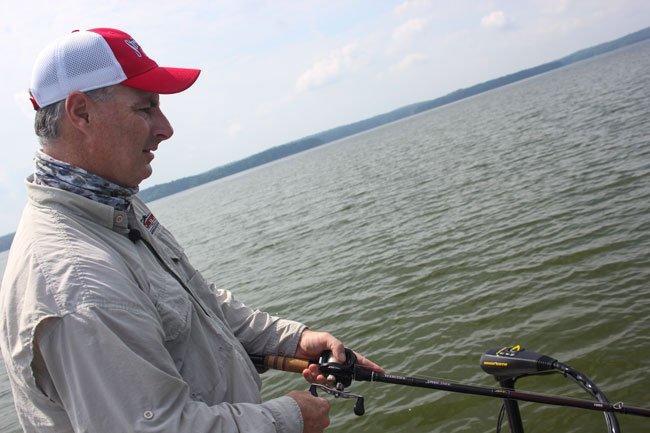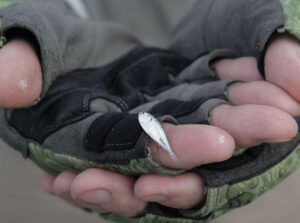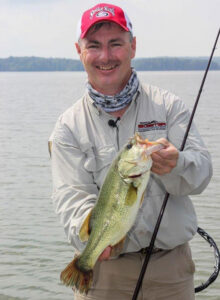It’s hot—and I’m certainly not referring to the bass fishing action as of late. As both the air and water temperatures continue to rise, the late-summer doldrums of bass fishing are quickly approaching. Before letting the frustration get the best of you, it’s imperative to consider the biological aspects of this period of instability.
Elite Series pro Mark Menendez is well respected in the fishing industry for his intimate knowledge of bass biology. In addition to spending the majority of his adult life pursuing bass throughout the country, he also has a degree in Fisheries Biology from Murray State University.
According to him, understanding the instinctual behavior of late-summer bass and contributing environmental factors will result in more fish catches and an increased sense of satisfaction on the water.
Anglers become gatherers
With the exciting opportunities springtime and early-summer bass fishing offers, anglers tend to get a bit spoiled by the time summer reaches its peak. After several months of catching big bass in very predictable areas, our heads are often left spinning when these substantial groups of fish disperse.
“When the water temperatures near the 80 to 90-degree mark, this fraternity of bass becomes much more exclusive and isolated. This means we need to adopt a ‘gatherer’ mindset and move around a lot more to find ’em.”
“In the post-spawn season, there will be mass congregations of fish that are relatively easy to locate,” Menendez said. “They simply slide out to nearby break lines in numbers to hang out and recuperate for a while. With the technology anglers have these days, we’re finding these schools and working on ‘em hard. When the water temperatures near the 80 to 90-degree mark, however, this fraternity of bass becomes much more exclusive and isolated. This means we need to adopt a ‘gatherer’ mindset and move around a lot more to find ’em.”
When these deep concentrations of bass disband, anglers need to understand two very important concepts.
The bass are stressed
“When the water quality breaks down and oxygen levels deplete as water temperatures rise, the bass get stressed out,” Menendez said. “Their metabolism is still high, but their strike zone becomes much smaller. They’re less apt to risk chasing down a meal and missing it because they know they need to conserve energy.”They’re still feeding—“Even though they may be hard to catch, bass are still feeding whenever they can,” Menendez said. “Their metabolism gives them the need to feed every three to four hours. We’ve just been spoiled by chunking deep crankbaits at big schools all summer. We get impatient when they stop chasing that big plug because it was game-on just a few weeks ago.”
Condominium bass
Once the deep schools of bass break up into smaller groups, they become what Menendez refers to as “condominium fish”. This is when it becomes important for anglers to dissect specific, isolated pieces of cover.
“As the thermocline starts building, bass will begin positioning inside of cover such as brush piles and stumps,” Menendez said. “They’re unlikely to chase prey from their new homes, so you need to fish very slowly to get bites. This is when big worms, drop shots and jigs play a very large role. You may have to leave your bait in a piece of cover for two to three minutes, so try your best to be patient.”
As a general rule, if you think you’re fishing slowly enough for these scattered bass, you should probably fish even slower. Menendez utilizes the “drop and lift” technique to draw strikes from these finicky bass.
“Whether I’m fishing a big worm or a jig, I’ll hang my bait over a limb of a brush pile,” Menendez said. “Then I’ll lift it up six inches, drop it back down six inches and repeat the process over and over. When it only drops down three inches, that’s when I have a bite. Your bites will be extremely subtle throughout this ‘condo’ phase, so always pay super-close attention.”
The thermocline sets in
To optimize your chances throughout the second stage of late-summer bass movement, it’s essential to understand the thermocline. If you can learn how it affects bass positioning and behavior, you’ll be far ahead of the game
“I spend a lot of time targeting areas with a lot of verticality because even though they’re suspended, big bass want to be close to deep water.”
“The thermocline is a temperature-related level at which the lake stratifies,” Menendez said. “Below the thermocline, the ecosystem has used all of the available oxygen, causing the levels to become very low. This is when you’ll see mussels floating on the surface—especially the small ones. You’ll also start seeing a consistent number of catfish or drum that have died due to suffocation. The water supports life much better above the thermocline, so the fish have to sit above it.”
Menendez keeps a close eye on his Lowrance electronics throughout this stage. A continuous horizontal line representing the thermocline will become visible on his sonar. At this point, he knows the bass are suspended.
“These bass have to breathe, so when the oxygen runs out in their condominiums, they have to move out,” Menendez said. “They’ll spend a week or two suspended above the thermocline and this is when you can absolutely wreck ‘em on a 3/4-ounce slow-rolled spinnerbait. I spend a lot of time targeting areas with a lot of verticality because even though they’re suspended, big bass want to be close to deep water.”
Cool August nights
Throughout the first part of August, most fisheries will experience approximately three or four nights of cooler-than-average temperatures. As a result, surface temperatures drop roughly two degrees which spurs an important occurrence.
Menendez’s go-to baits for late-summer bass
- Texas rigged 10-inch Strike King Rage Thumper Worm with 1/8-ounce weight
- Texas rigged 8-inch Strike King Rage Tail Tail ReCon Worm with 1/8-ounce weight
- 3/4-ounce Strike King Hack Attack Heavy Cover Spinnerbait
- Strike King 1.5 KVD HC Square Bill Silent Crankbait
“Those first few cool nights will spur a change in plankton and pH levels, resulting in decreased clarity,” Menendez said. “Whenever you notice the water color change, start concentrating your efforts in nearby bays.”
Two important things are happening at this point, according to Menendez.
Offshore fishing gets tough
“Your chances of successfully catching bass offshore will decrease as water clarity decreases,” Menendez said. “The bass will have a hard time locating your offerings and they just don’t feel as comfortable feeding out there.”The shad leave—“When this change happens, 30 to 40 percent of the shad will leave the main lake area and start heading back to the bays and a good percentage of the bass go with them,” Menendez said. “The shad relocate to the backs of creeks with fresh water to take advantage of all the nutrients. There will be some resident bass that live back there year-round, but now you have all the new guys coming in there, too. It’s a recipe for success many anglers overlook, so if you watch the weather, you can be the first guy back there and catch some huge bass.”
If the bass fishing hasn’t become challenging in your area yet, it will probably happen soon—but don’t let it deter you from enjoying what you love. If you can remain patient while implementing these lessons on your home fishery, you’ll enjoy plenty of fishing success when others tend to struggle.














